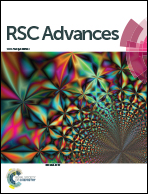Selective photocatalytic oxidation of aromatic alcohols into aldehydes by tungsten blue oxide (TBO) anchored with Pt nanoparticles†
Abstract
Achieving selective transformation of organic functional groups in an energy efficient and environmentally benign way is an important yet challenging endeavour in the field of chemical science. Utilization of heterogeneous photocatalysis for selective conversion holds great potential from cost, energy, and environment viewpoints. In this work, we report the fabrication of nanocomposites comprising hypostoichiometric tungsten oxide (WO3−x) modified with platinum nanoparticles and/or reduced graphene oxide (RGO) and their deployment in highly selective (>99%) and efficient (>80%) conversion of aromatic alcohols into corresponding aldehydes under simulated sunlight and ambient conditions. Efficacy of the nanocomposites was investigated by studying the oxidation of benzyl alcohol (BA), 4-methoxybenzyl alcohol (4-MBA) and cinnamyl alcohol (CA) into corresponding aldehyde, in terms of alcohol concentration, RGO and/or Pt loading, and the amount of photocatalyst employed. Systematic investigations on the chemical stability, recyclability, photocatalytic and photoelectrocatalytic aspects helped to shed light on the role of excitons towards the observed selectivity. A plausible mechanism to explain the observed attributes of the photocatalyst is proposed that provides impetus to design future photocatalysts with anticipated attributes for selective oxidation reactions.


 Please wait while we load your content...
Please wait while we load your content...